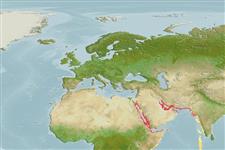Environment: milieu / climate zone / depth range / distribution range
Ökologie
seewasser demersal; tiefenbereich ? - 10 m (Ref. 100374). Tropical
Western Indian Ocean: Red Sea.
Size / Gewicht / Alter
Maturity: Lm ? range ? - ? cm
Max length : 21.8 cm SL Männchen/unbestimmt; (Ref. 28618); common length : 22.0 cm TL Männchen/unbestimmt; (Ref. 5450)
Oviparous, distinct pairing during breeding (Ref. 205).
Life cycle and mating behavior
Maturities | Fortpflanzung | Spawnings | Egg(s) | Fecundities | Larven
Oviparous, distinct pairing during breeding (Ref. 205).
Parenti, P. and J.E. Randall, 2000. An annotated checklist of the species of the labroid fish families Labridae and Scaridae. Ichthyol. Bull. J.L.B. Smith Inst. Ichthyol. (68):1-97. (Ref. 35918)
IUCN Rote Liste Status (Ref. 130435)
Bedrohung für Menschen
Harmless
Nutzung durch Menschen
Tools
Zusatzinformationen
Download XML
Internet Quellen
Estimates based on models
Preferred temperature (Ref.
123201): 24.7 - 29.2, mean 27.6 °C (based on 334 cells).
Phylogenetic diversity index (Ref.
82804): PD
50 = 0.5078 [Uniqueness, from 0.5 = low to 2.0 = high].
Bayesian length-weight: a=0.02188 (0.00887 - 0.05395), b=2.97 (2.76 - 3.18), in cm total length, based on LWR estimates for this (Sub)family-body shape (Ref.
93245).
Trophic level (Ref.
69278): 3.5 ±0.5 se; based on size and trophs of closest relatives
Widerstandsfähigkeit (Ref.
120179): mittel, Verdopplung der Population dauert 1,4 - 4,4 Jahre. (Preliminary K or Fecundity.).
Fishing Vulnerability (Ref.
59153): Low vulnerability (17 of 100).
Nutrients (Ref.
124155): Calcium = 166 [83, 443] mg/100g; Iron = 1.36 [0.44, 3.44] mg/100g; Protein = 16.7 [12.7, 20.0] %; Omega3 = 0.126 [0.061, 0.261] g/100g; Selenium = 34.6 [13.7, 88.9] μg/100g; VitaminA = 58.2 [8.9, 328.2] μg/100g; Zinc = 2.64 [1.47, 4.38] mg/100g (wet weight);
